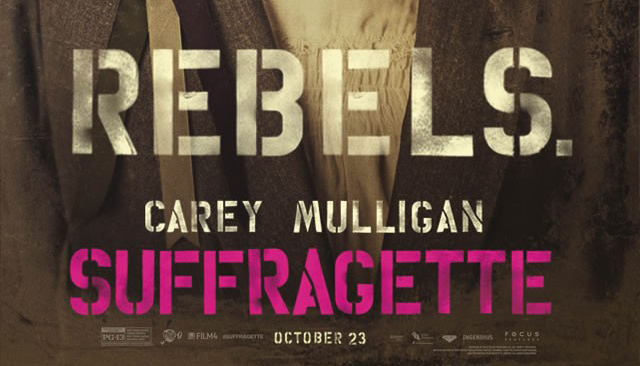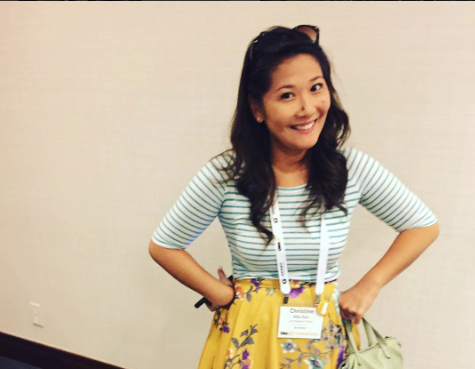The power of “Suffragette” stems from how personal it is.
The film follows the transformation of a British working-class woman in 1912. She starts off as a loving mother and devoted wife and, through personal crises, grows into a strong leading figure in the British Women’s Rights Movement.
“Suffragette” starts off like any other British period piece. It opens with Maud Watts, played by Academy Award-nominated actress Carey Mulligan, walking down a grimy street in London’s East End. Her face is worn, her body tired and her clothes as shabby as her soul.
Maud is happily married to Sonny, played by Ben Whishaw, and they are the proud parents of a little boy named George. Maud’s love for her son radiates off the screen and never wavers.
Both Maud and Sonny are employed at the same laundry mill, a bleak and depressing work environment run by a misogynistic middle-aged overlord who sexually abuses his female workers. Despite awful work conditions for Maud and other women, an unconventional female presence disrupts the work setting. Violet Miller, played by Anne-Marie Duff, defends herself against the male overseer and shouts “Votes for Women!” periodically throughout the workday.
 Violet tries to recruit Maud into joining the British Women’s Rights Movement. Maud resists at first in fear of social ridicule, but eventually finds her voice at a Parliament hearing in front of Chancellor of the Exchequer David Lloyd George a few weeks later. Despite threats to her domestic identity — halfway through the movie, Sonny kicks Maud from their home and puts up their son for adoption — Maud eventually grows into a voting rights advocate and challenges the political, social and economical spheres of the male patriarchy.
Violet tries to recruit Maud into joining the British Women’s Rights Movement. Maud resists at first in fear of social ridicule, but eventually finds her voice at a Parliament hearing in front of Chancellor of the Exchequer David Lloyd George a few weeks later. Despite threats to her domestic identity — halfway through the movie, Sonny kicks Maud from their home and puts up their son for adoption — Maud eventually grows into a voting rights advocate and challenges the political, social and economical spheres of the male patriarchy.
While Maud is a composite character drawn from several figures in the suffragette movement, she is surrounded by historical heavyweights such as Emmeline Pankhurst, the mother of the voting rights movement, and Emily Wilding Davison, who famously lost her life after stepping onto the track at the Epsom Derby to gain the attention of King George V. While Davison was holding a banner proclaiming “Votes for Women,” the king’s horse ran into her at top speed. After she died of her injuries in the hospital, Davison became a martyr for the movement.
Interestingly, screenwriter Abi Morgan noted that lost footage of Davison’s death at the derby was found after a film canister was discovered at the British Film Institute, and it was developed for the production of this movie.
Historically speaking, the British Women’s Rights Movement involved women from all walks of life. Interestingly, this film depicts working-class women as the foot soldiers, sacrificing their lives, families and reputations for the cause, while upper-class women hid from the law, quietly funding and organizing rallies from afar.
Among this diverse group, all of the women had their own personal ties to greater fight for voting rights. It wasn’t just about a collective rebellion, but the individual efforts of each female who wanted a better life for themselves.
Suffragette is also striking in its willingness to depict brutality against women in a harsh light. The film does not shy away from graphic images of women being beat up by male police officers at a rally or being force-fed in prison for going on hunger strikes. The images are jarring and emotional, but closer to reality than the bonnet-wearing, flower-toting, peacefully-walking suffragettes of “Mary Poppins.”
Any movie that covers the issues of gender equality faces the issue of pitting men versus women. It’s very easy to paint men as the villain and women as the strong, brave protagonists, which isn’t necessarily a bad thing if you want to do a straight historical portrayal of the fight for equality.
However, the interesting thing to note about “Suffragette” is that it’s not just a historical feature – it doesn’t want to relegate the fight to the past. Instead, it wants to pull the fight forward and make it applicable to today’s society. Indeed, with a hashtag like #FightsNotOver and closing cards that emphasize that women in Saudi Arabia have only been afforded the right to vote this very year, it seems to fulfill its role as a call-to-arms for modern-day suffragettes.
Today, women still are fighting for equality among male peers. As one audience member put it, “We still don’t have equal pay, but that’s another story.” Although most women have the right to vote, obtain an education, achieve custody and own stocks, there is still work that needs to be done.
The average woman makes 77 cents less than her male co-worker. It is appalling that we still don’t have equal pay in the workplace.
Although the original British Women’s Movement heroines are long gone, 103 years later we are still advocating for fair salaries.







You must be logged in to post a comment.